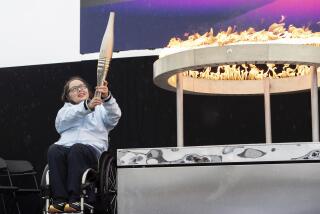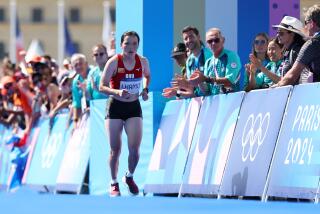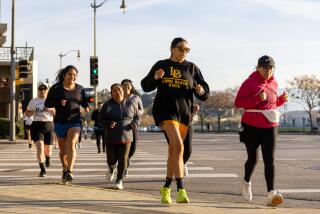Race Returns Home to a Different Greece
MARATHON, Greece — Runners in the first Olympic marathon in 1896 spent the night in this hamlet’s single “wretched” inn and downed a couple of beers before the race. Competitors today can stay at Club Med and pick up a Coke at the McDonald’s drive-thru.
The dirt track the first runners followed has been replaced with a four-lane highway. Pine forests and olive groves have given way to strip malls and urban sprawl. Villagers have traded traditional foustanella costumes for T-shirts and low-rise jeans.
The marathon is returning home to its namesake village northeast of Athens, the starting point of a race that ends in the capital at the same, marble Panathinaiko Stadium where the first modern games were held 108 years ago. The rest of the 26.2-mile route is unrecognizable.
And yet one thing has remained unchanged: Greeks’ love affair with the long-distance race, which began in 1896 when a farmer named Spyridon Louis pulled away from the 16 other runners to give Greece its first and only victory in the Olympic marathon.
“All Greece is very happy that the Olympics are here, but especially about the marathon,” said 87-year-old Yannis Politis, who bragged that he met Louis as a teenager. “I’ll be here on Sunday to see it.”
The marathon commemorates the path of the warrior Phidippides, who is said to have run from the battlefield in Marathon to Athens in 490 B.C. with word that the Greeks had defeated the Persians. According to legend, he cried out “We won!” and promptly dropped dead of exhaustion.
The marathon has no roots in the ancient Olympics, whose longest race was 2.87 miles. But when Greece held the first modern Olympics, organizers eager to honor the myth traced a route from a wooden bridge in Marathon to the stadium.
The village of Marathon had little to offer beyond a couple of small farmhouses and perhaps a tavern.
The 1884 edition of “Murray’s Hand-Book Greece,” preserved in Athens’ stately Gennadeios rare books library, describes a rough ride to Marathon, where “a wretched khan (inn) affords accommodation to the traveler for the night.”
Today, Marathon is a quiet, pleasant town with tourist shops selling replicas of ancient vases and a small museum with exhibits about marathons around the world. The tile roofs of older houses sag in the sun, while concrete apartments sit smartly amid gardens and vineyards.
Beside the town’s soccer field, spikes bearing the Athens 2004 logo are hammered into the ground to establish the start of a painted blue line that leads to Athens. A grassy ridge offers spectators a view of the runners.
Just outside Marathon, the line makes its only detour -- a loop to the left that circles the knoll commemorating Greek soldiers fallen in Marathon’s ancient battle. A statue of their commander, Gen. Miltiades, was erected last month.
Continuing the route, an alley to the left heads into Club Med Athenia, where white stucco villas preside over a gravelly beach. A McDonald’s -- the first of three along the route -- invites children to participate in the “Kids McAthlon” by getting their parents to buy them a Happy Meal.
The route hardly resembles the one Louis covered in 2 hours, 58 minutes, 50 seconds.
“He would have seen pine trees and vineyards -- those are really the only two things,” Kitroeff said. “Perhaps a couple of small farmhouses. No shops -- nothing at all.”
Today, runners could pause at a dealership to buy a Peugeot. Or a Mitsubishi, a Toyota, a Mercedes, a Renault, a Fiat, a Hyundai or a Volkswagen. They face the agonizing choice of where to get a facial: the Estee Lauder Beauty Salon, or the Dior Beauty Shop, whose storefront also offers a “Bikini Celluli-Diet.”
At Nea Makri, a series of strip malls begins -- and continues along Marathon Avenue, almost uninterrupted, all the way to Athens.
Lefteris Mavrikos, a 70-year-old farmer, said his family helped settle the area in 1922, 26 years after the first marathon. Taking a break from a game of cards at a coffee shop, he said inhabitants spent the first years living in tents amid a wild forest.
Now, there is a movie theater, a “Smile Park” playground and three pet shop franchises. The “Beautiful Night” nightclub offers a view of the road near Zoumberi, and a shop in Agios Andreas suggests installing a Jacuzzi.
Near the port of Rafina, there is a statue of “the marathon man,” presumably Philippides. “We won!” reads the plaque beneath the bronze figure, who reaches forward to hand over a scroll.
In Pikermi, there is a statue of Louis -- who, strangely, is depicted naked -- facing a church and a store where bikinis are on sale.
In Pallini, where Spyridon Louis would have seen only pine forests, there is now a pharmaceutical factory and a Pizza Athina, although Domino’s delivers as well.
Ambelokipi now hosts the U.S. Embassy, cement blocks lining the marathon route to guard against car bombs. But the route still ends where it did when Louis triumphantly entered the stadium to the incredulous shouts of “Hellene!” -- “a Greek” -- and a cloud of doves.
More to Read
Go beyond the scoreboard
Get the latest on L.A.'s teams in the daily Sports Report newsletter.
You may occasionally receive promotional content from the Los Angeles Times.










